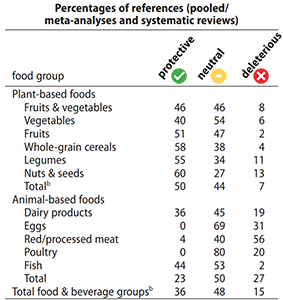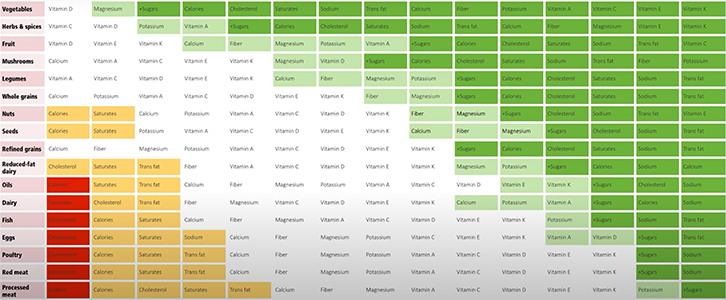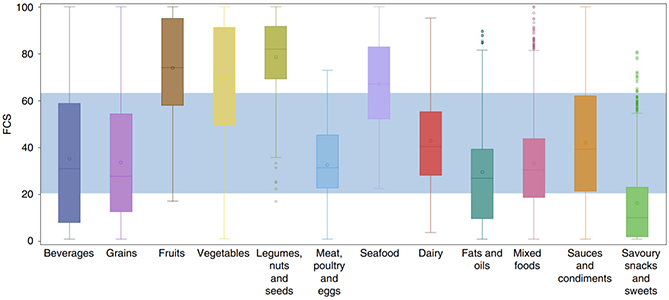When looking at the top sources of calories consumed by the average American, we get: #1 Desserts. #2 Breads. #3 Chicken. #4 Soda. and #5 Pizza [1]. Ladies and gentlemen, the Standard American Diet. After seeing this list, it made me wonder, what are the healthiest foods? If we were to gauge the healthiness of foods based on their protective effects against chronic disease, their nutrition label, and their complete nutrient profile, what foods groups would rise to the top? And what food groups should be our top sources of calories? Well, let’s get into it!
Food Groups and Chronic Disease Comparison
First, I wanted to look at the associations between food groups and the risk of diet-related chronic disease (DRCD). And for this, I found a fascinating study, of studies, of studies. That’s a mouthful. So, a meta-analysis or systematic review is a study of many studies. It’s an effective way to summarize findings found in the research world. But this study was a pool of meta-analyses and systematic reviews (PMASR). In other words, a summary of many summaries. And its aim was to determine what percentage of studies showed either protective, neutral, or deleterious effects on human health. What the present review of 304 PMASRs published between 1950 and 2013 confirmed was that plant food groups are more protective than animal food groups against diet-related chronic diseases. On top of that, it found almost no protective effects for eggs, red meat, or poultry [2]. The only animal-based food group that showed some promise is fish, but I still worry about its content of toxic heavy metals, dioxins, and PCBs because the most concentrated source of pollutants in our diet is our aquatic food chain [3]. Among the plant-based food groups, all whole plant foods appeared to perform equally well.

Food Groups and Nutrition Label Comparison
Second, I wanted to a way to compare food groups based upon metrics you’d find on their nutrition label like calories, fat, sugar, fiber, sodium, and select vitamins and minerals. For that, I found a video created by Dr. Greger at NutritionFacts.org that did just that. Dr. Greger listed 17 different food groups and then 15 different nutrients commonly found on a nutrition label. He then graded each food group based up the different nutrients by labeling them as green for “good to eat”, yellow for “caution”, and red for “avoid.” Finally, he sorted that list by which food group contained the healthiest foods and found vegetables, herbs & spices, fruit, mushrooms, legumes, whole grains, nuts, and seeds to be the healthiest. Oppositely, processed foods ranked the worst with red meat, poultry, eggs, fish, dairy, and oils not far behind [4].

Food Groups and Nutrient Profile
And third, while this review by Dr. Greger was extremely useful, he admits that it doesn’t cover many other important food qualities like phytochemicals, additives, and processing. Luckily, a paper was just published in the highly respected journal Nature, last month, which created a nutrient profiling system (NPS) that scored foods on 54 attributes across 9 health-relevant domains: nutrient ratios, vitamins, minerals, food ingredients, additives, processing, specific lipids, fiber & protein, and phytochemicals. Based on this information, foods were provided a final Food Compass Score (FCS), ranging from 1 (least healthy) to 100 (most healthy) [5]. What they found was the lowest scoring category was snacks and sweet desserts with an average score 16.4. After that, beef came in around 25, poultry 43, and seafood 67. But here at myHealthSciences we aren’t looking for passing scores, we’re looking for optimal scores. And to that the highest scoring categories were vegetables, legumes, nuts, seeds, and fruit. With nearly all raw foods receiving a score of 100 [6].

Final Thoughts
While there’s no clear and exact way to determine which foods are the healthiest, these three studies give us a promising idea of what to focus on. Whether we’re worried about chronic disease, adequate nutrient intake, or living the healthiest way possible, plant-based food groups clearly take the lead. This means eating a diet of predominantly vegetables, fruits, whole grains, legumes, nuts, and seeds. And maybe some seafood if you don’t mind polluting your digestive tract mercury and microplastics. Up to you. Dealer’s choice.

